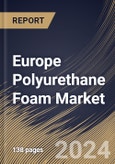The flexible iteration of polyurethane foam has found its niche in the automotive sector, adorning car seats and interior components due to its exceptional comfort, resilience, and lightweight composition. Its application extends beyond vehicles, infiltrating the realms of furniture and bedding, where its cushioning properties and durability have made it a preferred choice for mattresses, sofas, and other comfort-enhancing furnishings. Furniture items benefit from the resilience and longevity of these, ensuring consumer satisfaction and longevity in these markets.
The market's relentless growth trajectory is propelled by a convergence of factors, including an increasing emphasis on energy conservation and sustainability, technological advancements driving material innovations, and a burgeoning demand for high-performance materials across industries. Additionally, stringent environmental regulations and a shifting consumer landscape increasingly favour eco-friendly alternatives, stimulating the development of bio-based and environmentally sustainable variants. The constant drive for energy-efficient solutions across industries remains a significant catalyst for the market.
The relationship between the automotive sector and the market is integral and interdependent, with these as a crucial material in enhancing comfort, safety, acoustic performance, and design flexibility within vehicles. The demand for polyurethane foam within the automotive sector remains consistently high. As per the same source, Switzerland registered more than 6.3 million vehicles in 2021, a 38% increase from 2000. Compared to 2019, sales of exclusively electric vehicles increased by 62.1% in 2022, accounting for 9.2% of newly registered automobiles. Therefore, the progress of the automotive sector in the region is propelling the growth of the market.
The Germany market dominated the Europe Polyurethane Foam Market by Country in 2022 and would continue to be a dominant market till 2030; thereby, achieving a market value of $4,260.2 million by 2030. The UK market is exhibiting a CAGR of 6.1% during (2023 - 2030). Additionally, The France market would experience a CAGR of 7.8% during (2023 - 2030).
Based on Product, the market is segmented into Flexible Foam, and Rigid Foam. Based on Application, the market is segmented into Bedding & Furniture, Transportation, Construction, Packaging, Electronics, Footwear, and Others. Based on countries, the market is segmented into Germany, UK, France, Russia, Spain, Italy, and Rest of Europe.
List of Key Companies Profiled
- Huntsman Corporation
- The Dow Chemical Company
- BASF SE
- Sekisui Chemical Co., Ltd.
- Saint-Gobain Group
- Rogers Corporation
- UFP Technologies, Inc.
- Trelleborg AB
- Future Foam, Inc.
- Foamcraft, Inc.
Market Report Segmentation
By Product (Volume, Kilo Tonnes, USD Billion, 2019-2030)- Flexible Foam
- Rigid Foam
- Bedding & Furniture
- Transportation
- Construction
- Packaging
- Electronics
- Footwear
- Others
- Germany
- UK
- France
- Russia
- Spain
- Italy
- Rest of Europe
Table of Contents
Companies Mentioned
- Huntsman Corporation
- The Dow Chemical Company
- BASF SE
- Sekisui Chemical Co., Ltd.
- Saint-Gobain Group
- Rogers Corporation
- UFP Technologies, Inc.
- Trelleborg AB
- Future Foam, Inc.
- Foamcraft, Inc.
Methodology

LOADING...








